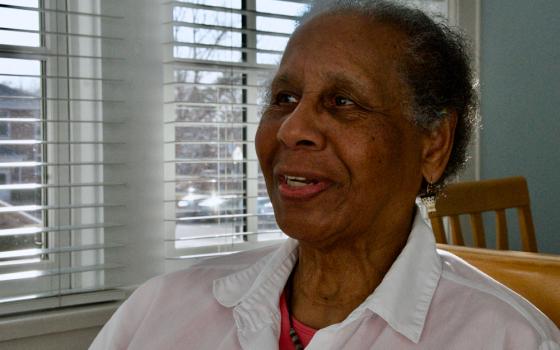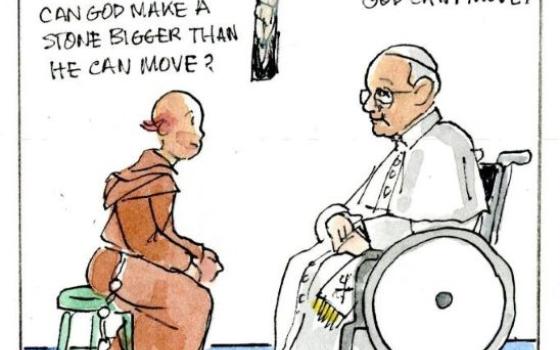NEWMAN’S UNQUIET GRAVE: THE RELUCTANT SAINT
By John Cornwell
Published by Continuum, $24.95
John Henry Newman, an English Catholic cardinal and former Anglican renowned for his scholarship and writing, is to be beatified in Birmingham, England, on Sept. 19 by Pope Benedict XVI.
The pope is a keen student of Newman’s writing. Pope Paul VI had said that the Second Vatican Council was “Newman’s Council,” because the majority of council fathers and their theologians had imbibed Newman’s views on historicity, the use of patristics and scripture, development, conscience, the role of the laity in the intellectual life of the church, the desire for the unity of the church, and a sober and constrained devotion to Mary.
 When Newman died at 89 he had spent exactly half his life in the Anglican Communion and half in the Roman Catholic church. His close friend, Richard Church, the Anglican dean of St Paul’s Cathedral, wrote, “Great as his services have been to the communion in which he died, they are as nothing by the side of those he rendered to the communion in which the most eventful years of his life were spent.”
When Newman died at 89 he had spent exactly half his life in the Anglican Communion and half in the Roman Catholic church. His close friend, Richard Church, the Anglican dean of St Paul’s Cathedral, wrote, “Great as his services have been to the communion in which he died, they are as nothing by the side of those he rendered to the communion in which the most eventful years of his life were spent.”
The dean referred to Newman’s role between 1833 and 1841 in the “Tractarian Movement,” an attempt by Oxford-based high church Anglicans, through widely circulated and influential tracts, or pamphlets, to bring the Church of England to conformity with its Catholic past. This changed the face of the Anglican church.
With Newman’s Unquiet Grave, first published in Britain earlier this year, John Cornwell, an English writer unafraid to address controversial issues (he is the author of Hitler’s Pope: The Secret History of Pius XII and The Pontiff in Winter: Triumph and Conflict in the Reign of John Paul II), has again stirred up passions. But first, Newman.
Cornwell has provided a most readable and scholarly account of Newman’s life: an evangelical boyhood in a commercial middle-class family, his years in Oxford as an undergraduate of Trinity College, a fellow of Oriel College and vicar of the University Church.
Then comes “the parting of friends,” with his conversion to the Roman Catholic church, his founding of the Oratories in Birmingham and London, his foundation of the Catholic University in Dublin, and his nearly 70 years work as pastor, preacher and controversialist (a term he preferred to theologian). Newman published 36 volumes in his own edition of his writings (and there have been posthumous volumes); his edited letters and diaries fill 32 volumes. Cornwell examines in their context all Newman’s major works, including The Arians of the Fourth Century, An Essay on the Development of Christian Doctrine, The Idea of a University, An Essay in Aid of a Grammar of Assent, and The Dream of Gerontius (a poem later set to music by Edward Elgar).
Newman’s Unquiet Grave describes how, particularly during Pius IX’s later years, Newman suffered from what might now be called depression: “I am nobody. I have no friend at Rome, I have laboured in England to be misrepresented, backbitten and scorned. I have laboured in Ireland, with a door ever shut in my face. I seem to have had many failures, and what I did well was not understood. I do not think I am saying this in any bitterness.”
He also felt increasingly uncomfortable with excessive clericalism, creeping infallibility and Roman centralization.
Cornwell reveals how difficult Newman found it, “looking at it in a temporal earthly point of view,” to live in the Catholic church. He had to respond to rumors that he was about to leave it. He confided to Westminster’s Cardinal Henry Manning, a confidence he would regret: “I have found very little but desert and desolateness ever since I have been in it -- that I have nothing pleasant to look back on, that all my human affections were with those whom I had left.” He listed Catholic shortcomings: They were not a powerful organization, they acted in a “second best way in a worldly aspect.” They did not possess “deep, subtle, powerful intellects,” they lacked education, they were not rich, first-class spiritual direction was rare and theological schools sparse. Their advantages, he said, were supernatural.
In his last years, Newman was elected to an honorary fellowship of Trinity College, Oxford, in 1877 and was made a cardinal in 1878. He enjoyed international acclaim and renewed friendships with Anglican colleagues. He admitted that the cloud over him had been lifted.
The cloud has not necessarily lifted over Cornwell, though his book deserves better than some criticism it has received, for his judgment is sure and careful while his book has become a lightning rod for contentious issues surrounding the beatification.
 The book’s title refers to the excavation of Newman’s grave in 2008 so that his remains could be taken to a more accessible place in the Birmingham Oratory for public veneration. A brass inscription, some wood and cloth from his coffin were found, but no remains of the body. There were no relics. Newman had ordered that a rich mulch be placed in the saturated clay of the grave to hasten decomposition, an acknowledgement of his sinfulness, deserving of final physical corruption and a return to dust, in certain hope of resurrection.
The book’s title refers to the excavation of Newman’s grave in 2008 so that his remains could be taken to a more accessible place in the Birmingham Oratory for public veneration. A brass inscription, some wood and cloth from his coffin were found, but no remains of the body. There were no relics. Newman had ordered that a rich mulch be placed in the saturated clay of the grave to hasten decomposition, an acknowledgement of his sinfulness, deserving of final physical corruption and a return to dust, in certain hope of resurrection.
Newman’s strong and explicit wish to be buried with his close friend and companion-servant in the Oratory, Ambrose St. John, who had predeceased him, had not been respected. The burial of the two priests in the same grave had raised questions about their sexuality, that Newman could have been gay and that the translation of his remains was recently effected to avoid embarrassment. Cornwell does not draw this conclusion and quotes Ian Ker, Newman’s biographer, that all of the evidence points to Newman’s being heterosexual.
The Times Literary Supplement’s Anthony Kenny commends Cornwell’s sensitive treatment.
Cornwell examines Newman’s deep friendships with both men and women (Newman rejected the fear of “particular friendships”), and concludes that “Newman’s greatest gift to the daily lives of Roman Catholic priests may yet be a lesson in the scope for mature, intimate friendship within a life of priestly celibacy.”
What really has the critics tripping over themselves to counterattack was Cornwell’s examination of Newman’s subtle views on miracles, and the particular miracle accepted for Newman’s beatification (a Boston man’s recovery from spinal deformities, though there had been intervening surgery). Clifford Longley in The Tablet argues that “the church’s reliance on miracles to prove God’s certification of the [canonization] process strains credulity.” I tend to the side of Kenny and Longley.
Finally, it is good to remember the man soon to be beatified. He can be viewed from many aspects, and can be understood only after much searching. He was shy, sensitive, devout, liberal-minded, brave, cultivated, and familiar with the academy as well as the church. He foresaw the loss of faith among the educated classes spreading to every dimension of culture and society. His Apologia pro Vita Sua is still considered one of the greatest of religious autobiographies. James Joyce believed him to be the greatest prose stylist of the Victorian age. Modern scholarship on him proliferates. His companion in old age in the Oratory said that Newman even prayed with “a pen in his hand.” He is an attractive model of integrity and holiness.
Cornwell has provided what he intended to write: “a shorter, less academic account of Newman’s life, accessible not only to Catholics but non-Catholics and non-Christians as well.” His interest focuses not on Newman’s holiness but on his character and importance as a writer. He argues that Newman’s claim to eminence consists in his genius for creating new ways of imagining and writing about religion, for “Newman’s unrelenting literary obsession was the story of his own life.” Cornwell has achieved that with a finely crafted work.
[Jesuit Fr. Peter L’Estrange is special assistant to the president of Georgetown University in Washington.]
John Allen will be filing reports throughout the Papal visit to the U.K. Sept. 16-19. Stay tuned to NCR Today for updates.



